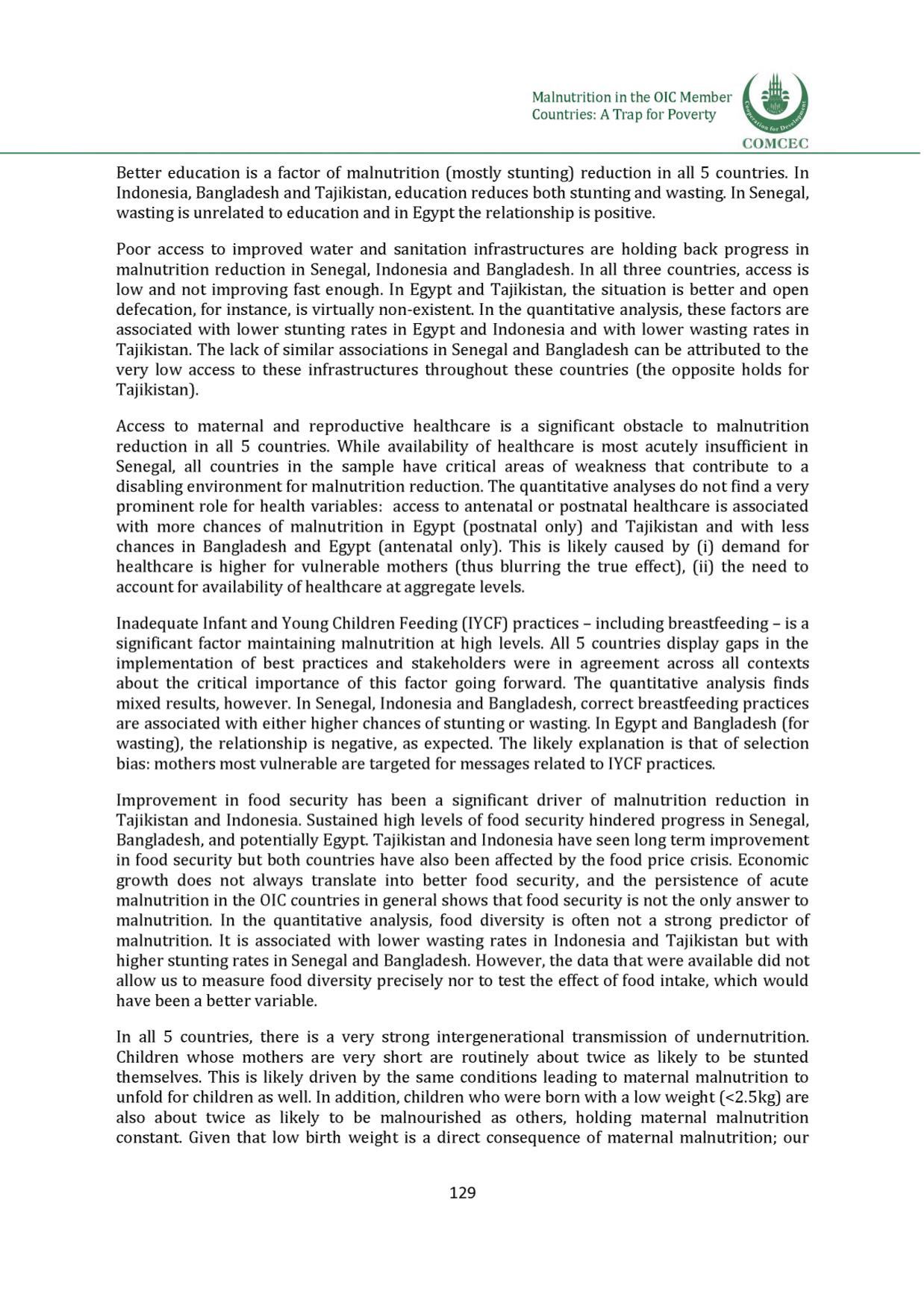

Malnutrition in the OIC Member
Countries: A Trap for Poverty
Better education is a factor of malnutrition (mostly stunting) reduction in all 5 countries. In
Indonesia, Bangladesh and Tajikistan, education reduces both stunting and wasting. In Senegal,
wasting is unrelated to education and in Egypt the relationship is positive.
Poor access to improved water and sanitation infrastructures are holding back progress in
malnutrition reduction in Senegal, Indonesia and Bangladesh. In all three countries, access is
low and not improving fast enough. In Egypt and Tajikistan, the situation is better and open
defecation, for instance, is virtually non-existent. In the quantitative analysis, these factors are
associated with lower stunting rates in Egypt and Indonesia and with lower wasting rates in
Tajikistan. The lack of similar associations in Senegal and Bangladesh can be attributed to the
very low access to these infrastructures throughout these countries (the opposite holds for
Tajikistan).
Access to maternal and reproductive healthcare is a significant obstacle to malnutrition
reduction in all 5 countries. While availability of healthcare is most acutely insufficient in
Senegal, all countries in the sample have critical areas of weakness that contribute to a
disabling environment for malnutrition reduction. The quantitative analyses do not find a very
prominent role for health variables: access to antenatal or postnatal healthcare is associated
with more chances of malnutrition in Egypt (postnatal only) and Tajikistan and with less
chances in Bangladesh and Egypt (antenatal only). This is likely caused by (i) demand for
healthcare is higher for vulnerable mothers (thus blurring the true effect), (ii) the need to
account for availability of healthcare at aggregate levels.
Inadequate Infant and Young Children Feeding (IYCF) practices - including breastfeeding - is a
significant factor maintaining malnutrition at high levels. All 5 countries display gaps in the
implementation of best practices and stakeholders were in agreement across all contexts
about the critical importance of this factor going forward. The quantitative analysis finds
mixed results, however. In Senegal, Indonesia and Bangladesh, correct breastfeeding practices
are associated with either higher chances of stunting or wasting. In Egypt and Bangladesh (for
wasting), the relationship is negative, as expected. The likely explanation is that of selection
bias: mothers most vulnerable are targeted for messages related to IYCF practices.
Improvement in food security has been a significant driver of malnutrition reduction in
Tajikistan and Indonesia. Sustained high levels of food security hindered progress in Senegal,
Bangladesh, and potentially Egypt. Tajikistan and Indonesia have seen long term improvement
in food security but both countries have also been affected by the food price crisis. Economic
growth does not always translate into better food security, and the persistence of acute
malnutrition in the OIC countries in general shows that food security is not the only answer to
malnutrition. In the quantitative analysis, food diversity is often not a strong predictor of
malnutrition. It is associated with lower wasting rates in Indonesia and Tajikistan but with
higher stunting rates in Senegal and Bangladesh. However, the data that were available did not
allow us to measure food diversity precisely nor to test the effect of food intake, which would
have been a better variable.
In all 5 countries, there is a very strong intergenerational transmission of undernutrition.
Children whose mothers are very short are routinely about twice as likely to be stunted
themselves. This is likely driven by the same conditions leading to maternal malnutrition to
unfold for children as well. In addition, children who were born with a low weight (<2.5kg) are
also about twice as likely to be malnourished as others, holding maternal malnutrition
constant. Given that low birth weight is a direct consequence of maternal malnutrition; our
129
















